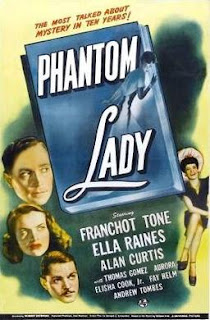Phantom Lady
Phantom Lady is a decent if unexceptional noir from 1944, directed by Robert Siodmak. It is at heart a murder mystery, and provides a surprise in the middle of the film, as the killer is revealed to the audience but not to the characters, fulfilling Alfred Hitchcock's rule of suspense. Instead of a shock ending, it's a slow build of terror.
The opening shot is of a woman's hat, which will be a key to the stoty. It is worn by a woman who is in a bar, feeling sorry for herself. A man (Alan Curtis) comes in, and offers her a pair of tickets to a show, as he has been stood up. She declines, and then he wonders if she'll go with him, as they are both down in the dumps. She agrees, on the condition that they not reveal each other's names.
When Curtis comes home, he finds police in his apartment. His wife has been murdered, strangled with one of his neckties. He is the immediate suspect, and he has an alibi. But everyone who saw Curtis and the woman together--the bartender, a cab driver, the drummer in the band at the show--deny seeing him with a woman. A search is madc for the woman with the hat, but she can't be found.
Curtis is found guilty and sentenced to death. His loyal secretary, Ella Raines, doesn't give up, and works with the cop who arrested him, Thomas Gomez, who also believes he's innocent. The real killer has bribed these witnesses.
As to who is the killer, the savvy viewer will figure that out, but the reveal works well, as he's introduced by visiting the drummer, Elisha Cook Jr. Raines has flirted with Cook and got him to confess being bribed, and the killer shows up to silence him. It's a great scene, as the killer shows his madness, and just before Cook is murdered the killer's shadow covers his face.
I don't want to spoil anymore, but it's a good ending if not a bit contrived. For 1944, this is an early example of psychology being a part of a murder story. Gomez has a speech about paranoiacs, and how they are narcissistic and insane, which he gives in front of the killer (Gomez doesn't know that at the time).
A word about Raines, who is the star of the film. She is uncommonly beautiful, and for a while was a hot commodity, appearing on the cover of Life twice. But her career never took off and she retired in 1957. That's too bad, as she's quite appealing.
The opening shot is of a woman's hat, which will be a key to the stoty. It is worn by a woman who is in a bar, feeling sorry for herself. A man (Alan Curtis) comes in, and offers her a pair of tickets to a show, as he has been stood up. She declines, and then he wonders if she'll go with him, as they are both down in the dumps. She agrees, on the condition that they not reveal each other's names.
When Curtis comes home, he finds police in his apartment. His wife has been murdered, strangled with one of his neckties. He is the immediate suspect, and he has an alibi. But everyone who saw Curtis and the woman together--the bartender, a cab driver, the drummer in the band at the show--deny seeing him with a woman. A search is madc for the woman with the hat, but she can't be found.
Curtis is found guilty and sentenced to death. His loyal secretary, Ella Raines, doesn't give up, and works with the cop who arrested him, Thomas Gomez, who also believes he's innocent. The real killer has bribed these witnesses.
As to who is the killer, the savvy viewer will figure that out, but the reveal works well, as he's introduced by visiting the drummer, Elisha Cook Jr. Raines has flirted with Cook and got him to confess being bribed, and the killer shows up to silence him. It's a great scene, as the killer shows his madness, and just before Cook is murdered the killer's shadow covers his face.
I don't want to spoil anymore, but it's a good ending if not a bit contrived. For 1944, this is an early example of psychology being a part of a murder story. Gomez has a speech about paranoiacs, and how they are narcissistic and insane, which he gives in front of the killer (Gomez doesn't know that at the time).
A word about Raines, who is the star of the film. She is uncommonly beautiful, and for a while was a hot commodity, appearing on the cover of Life twice. But her career never took off and she retired in 1957. That's too bad, as she's quite appealing.



Comments
Post a Comment